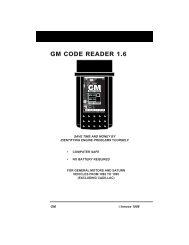Create successful ePaper yourself
Turn your PDF publications into a flip-book with our unique Google optimized e-Paper software.
Onboard Diagnostics<br />
OBD2 MONITORS<br />
NOx Aftertreatment Monitor - NOx aftertreatment is based on a<br />
catalytic converter support that has been coated with a special<br />
washcoat containing zeolites. NOx Aftertreatment is designed to reduce<br />
oxides of nitrogen emitted in the exhaust stream. The zeolite acts as a<br />
molecular "sponge" to trap the NO and NO2 molecules in the exhaust<br />
stream. In some implementations, injection of a reactant before the<br />
aftertreatment purges it. NO2 in particular is unstable, and will join with<br />
hydrocarbons to produce H2O and N2. The Nox Aftertreatment Monitor<br />
monitors the function of the Nox aftertreatment to ensure that tailpipe<br />
emissions remain within acceptable limits.<br />
The Nox Aftertreatment Monitor is supported by “compression ignition”<br />
vehicles only. The Nox Aftertreatment Monitor is a “Two-Trip” Monitor. If<br />
a fault is found on the first trip, the computer temporarily saves the fault<br />
in its memory as a Pending Code. The computer does not command the<br />
MIL on at this time. If the fault is sensed again on the second trip, the<br />
computer commands the MIL “On,” and saves the code in its long-term<br />
memory.<br />
Boost Pressure System Monitor - The boost pressure system<br />
serves to increase the pressure produced inside the intake<br />
manifold to a level greater than atmospheric pressure. This increase in<br />
pressure helps to ensure compete combustion of the air-fuel mixture.<br />
The Boost Pressure System Monitor checks for component integrity and<br />
system operation, and tests for faults in the system. The computer runs<br />
this Monitor once per trip.<br />
The Boost Pressure System Monitor is supported by “compression<br />
ignition” vehicles only. The Boost Pressure System Monitor is a “Two-<br />
Trip” Monitor. If a fault is found on the first trip, the computer temporarily<br />
saves the fault in its memory as a Pending Code. The computer does<br />
not command the MIL on at this time. If the fault is sensed again on the<br />
second trip, the computer commands the MIL “On,” and saves the code<br />
in its long-term memory.<br />
Exhaust Gas Sensor Monitor - The exhaust gas sensor is used<br />
by a number of systems/monitors to determine the content of the<br />
exhaust stream. The computer checks for component integrity, system<br />
operation, and tests for faults in the system, as well as feedback faults<br />
that may affect other emission control systems.<br />
The Exhaust Gas Sensor Monitor is supported by “compression ignition”<br />
vehicles only. The Exhaust Gas Sensor Monitor is a “Two-Trip” Monitor.<br />
If a fault is found on the first trip, the computer temporarily saves the<br />
fault in its memory as a Pending Code. The computer does not<br />
command the MIL on at this time. If the fault is sensed again on the<br />
second trip, the computer commands the MIL “On,” and saves the code<br />
in its long-term memory.<br />
OBD2&1 25




